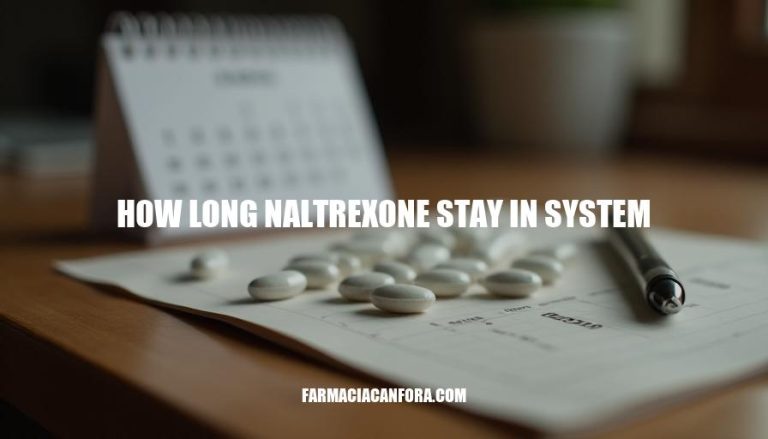


Naltrexone is a medicine used to help people with opioid use disorder and alcohol dependence. It’s good for both patients and doctors to know how long it stays in the body because it affects how well it works and what side effects might happen. This helps make sure the treatment plan is right and that people don’t go back to using drugs or drinking too much.
Naltrexone‘s duration in the system is influenced by several factors, including dosage, metabolism, and individual health conditions.
Dosage: The amount of naltrexone taken plays a significant role in how long it stays in the system. For instance, oral naltrexone has a half-life of about 4 hours, while its active metabolite, 6β-naltrexol, has a half-life of around 13 hours. This means that the medication and its metabolites can remain in the system for approximately 20 to 78 hours, depending on the dosage.
Metabolism: Individual metabolic rates can affect how quickly naltrexone is processed and eliminated from the body.
Factors such as age, gender, and liver function can influence metabolism. For example, women tend to have higher metabolic ratios of 6β-naltrexol to naltrexone compared to men. Additionally, concomitant use of other medications can impact naltrexone’s metabolism.
Health Conditions: Pre-existing health conditions, particularly those affecting the liver, can alter how naltrexone is metabolized.
Chronic pain patients, for instance, may have different metabolic rates and excretion patterns compared to healthy individuals. This variability can lead to differences in the duration naltrexone stays in the system.
Research Findings: Studies have shown that naltrexone’s receptor occupancy can vary based on dosage and chronic use. For example, chronic dosing of 16 mg naltrexone occupied 70-80% of receptors, while higher doses of 32 mg and 48 mg reached 90% occupancy.
This indicates that higher doses can lead to longer-lasting effects.
In summary, the duration naltrexone stays in the system is a complex interplay of dosage, individual metabolism, and health conditions. Understanding these factors can help tailor treatment plans for better efficacy and safety.
Naltrexone‘s duration in the body is influenced by several factors, including dosage, metabolism, and individual health conditions.
The amount of naltrexone taken plays a significant role, with oral naltrexone having a half-life of about 4 hours and its active metabolite, 6β-naltrexol, having a half-life of around 13 hours. This means that the medication and its metabolites can remain in the system for approximately 20 to 78 hours.
Individual metabolic rates, age, gender, liver function, and concomitant use of other medications can also impact how quickly naltrexone is processed and eliminated from the body. Pre-existing health conditions, particularly those affecting the liver, can alter how naltrexone is metabolized.
Research has shown that higher doses of naltrexone can lead to longer-lasting effects, with chronic dosing occupying 70-80% of receptors at a dose of 16 mg and reaching 90% occupancy at higher doses. However, it’s essential to note that the duration naltrexone stays in the system is a complex interplay of various factors.
Consulting healthcare professionals for personalized information and advice is crucial to ensure effective treatment plans and minimize potential side effects. They can help tailor treatment plans based on individual needs, taking into account dosage, metabolism, and health conditions.